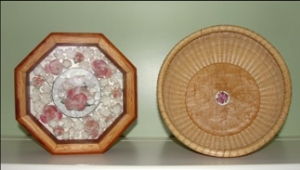The unique, natural beauty of the Cape and Islands and its rich nautical history
have inspired equally unique and compelling artwork for generations. From the beautiful
scrimshaw hewn by idle sailors during the whaling days to the exquisite Sailor’s
Valentines, the area continues to inspire world-renown artists and craftsmen.

Sailor's Valentine and Nantucket basket with inlaid scrimshaw
Undoubtedly, the Cape Cod Museum
of Art provides the most comprehensive display of regional arts and crafts,
old and new. Located just off Route 6A in Dennis, the museum offers a myriad of
exhibits including one entitled "Collection in Context: Experiments in Seascapes," featuring works from the Museum’s
permanent collection. The Museum displays a variety of media including paintings, sculpture, photography, prints, and architecture.
As stated on their website, "Beginning with John Audubon in 1835, men and women
of talent and imagination have been attracted to the light, the lifestyle, and the
totality of the area’s varied visual experiences." Open year round, the Museum offers
special events, art classes, and a museum shop as well as rotating exhibits. Admission
is free for children under 12.
Have you ever heard of Sailor’s Valentines? In the 19th Century, these intricate
mosaics of colorful seashells were thought to have been created by sailors from
the area and brought back for their waiting loved ones. In fact, the heart-shaped
creations were originally crafted in Barbados and merely purchased by the sailors
as gifts. Although there are a few others attempting to keep this legendary artwork
alive on the Cape today, perhaps the best display of exquisite new Valentines are
found in Yarmouth Port at the
Sailor’s Valentine Studio of artist Sandy Moran.
The art of scrimshaw is believed by many to be the only art form originating from
New England. Unlike Sailor’s Valentines, these were indeed actually carved by sailors
whittling away their time on board their whaling ships in the 19th Century. They
were most often carved from the plentiful sperm whales’ teeth and usually depicted
the sailors’ ships or captains. With the end of the whaling industry in the late
1800’s, the art of scrimshaw almost came to an end. It wasn’t until the early 1960’s
that President John F. Kennedy’s keen interest in scrimshaw brought about renewed
interest in the art form. The craft continues to be performed today, the ivory often
coming from the fossilized remains of the 10,000 year old Wooly Mammoth and Mastodon,
primarily unearthed in Siberia. Both antique and modern pieces of scrimshaw can
be viewed and purchased at any of the many shops and galleries on the Cape and Islands.
Be sure to visit our local museums, galleries, and studios – all within a convenient
travelling distance from your favorite Cape Cod
rental.